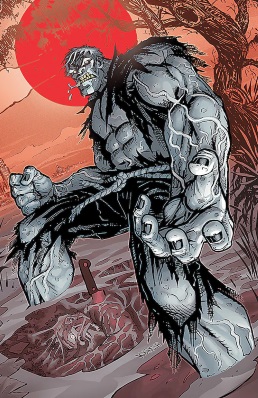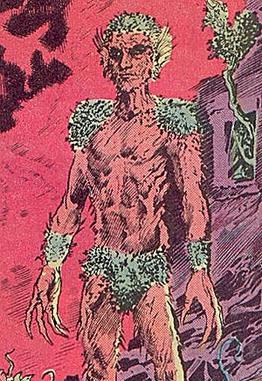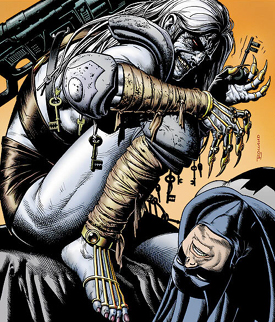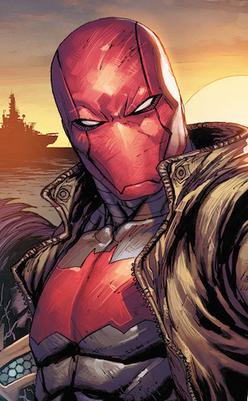Fictional character biography
| Crazy Quilt | |
|---|---|
 The first appearance of Crazy Quilt, as depicted on the cover of Boy Commandos #15 (May 1946); art by Jack Kirby. | |
| Publication information | |
| Publisher | DC Comics |
| First appearance |
|
| Created by |
|
| In-story information | |
| Alter ego | Unknown Paul Dekker Unidentified female |
| Species | Human |
| Abilities |
|
Earth-Two Crazy Quilt
Crazy Quilt is an unnamed noted painter who leads a double-life as a master criminal. He gives the plans for his crimes to various henchmen through clues left in his paintings. However, he is blinded by a gunshot wound after one of his henchmen betrays him. Subsequently, he volunteers for an experimental procedure to restore his vision, but is left unable to see anything but bright colors. [2] In his second published appearance, he largely regains his vision using a special helmet that emits bright colored lights. [3]
Paul Dekker
In a 1963 issue of Blackhawk taking place on Earth-One, a fence named Paul Dekker uses the name Crazy Quilt, but the title heroes capture him. [4] As a result of this appearance, some resources report the original Crazy-Quilt's true identity as Dekker. This includes at least one comic, the Kevin Smith-penned Batman: The Widening Gyre #4. However, the earlier Batman Encyclopedia, another official source endorsed by DC Comics, states that Dekker is a separate character from the original Crazy Quilt. [5]
In the Post-Crisis, Paul Dekker's history is similar to the Earth-Two Crazy Quilt. Crazy Quilt's sight is restored briefly after he kidnaps a surgeon to assist him. Batman and Robin intervene, during which Crazy Quilt is blinded again after Robin reflects his light beams at him. Obsessing over his young adversary, he becomes one of the few bat-villains to hate Robin more than his mentor. [6]
Later, attempting to enact revenge upon Robin, Crazy Quilt mistakenly takes out his aggression on Jason Todd, nearly killing him. [7] He later fought Jason Todd again after knocking Batman unconscious. [8]
When Ra's al Ghul caused a mass prison break at Arkham Asylum and Blackgate Penitentiary, Crazy Quilt was among the freed inmates that worked for Ra's al Ghul by abducting Alfred Pennyworth, Commissioner James Gordon, Vicki Vale, Harvey Bullock, and Julia Pennyworth. [9]
Crazy Quilt was later seen in Arkham Asylum when Batman was Arkham Asylum's latest patient. [10] He joins the other inmates in attacking Batman who ends up defeating them. [11]
During the Underworld Unleashed storyline, Crazy Quilt was among those who were offered a carved black candle of Neron. [12]
Crazy Quilt appears in the Belle Reve riot in Justice League #34, lugging around the eviscerated body of the prison warden. The prisoners, along with much of humanity, were being affected by the entity Mageddon and the mind control of Hector Hammond. [13]
Crazy Quilt also has a role in one of the many incarnations of the Secret Society of Super Villains. He and dozens of villains gather in response to the JLA's new moon base and extended team efforts. During the meeting, Quilt has his outfit insulted by the Monocle. The meeting turns out to be a JLA trap and all the villains are captured. [14]
In The New 52 (a 2011 reboot of the DC Comics universe) during the story arc Batman: Endgame , Dr. Paul Dekker appears as insane ex-Wayne Enterprises geneticist who Batman suspects supplied the Joker with his newest serum filled with Dionesium, but is found out to not be guilty. He is also a member of the Doctors Three along with Doctor Death and Hugo Strange. Dekker calls out claiming that the Joker has given him the opportunity to become one of the "Dionesium Men" as well and gleefully injects himself with a syringe despite Batman's warnings. Almost immediately, Dekker's tissues begin to decay and rot from his body and he drops from the window into the waiting crowd of infected who tear what remains of him to pieces. [15] In a nod to his pre- Crisis alter ego, Dekker is found covering his nude body with a patchwork quilt.
Female Crazy Quilt
An unnamed, female version of Crazy Quilt appears as a member of Alexander Luthor Jr.'s version of the Secret Society. She works with many other supervillains to take down the Secret Six. [16] In Outsiders #50, she is captured by the Suicide Squad.
In the Secret Six series, she is one of the villains who accepts the offer of a bounty on the Secret Six from mysterious crime boss Junior, only to be gravely wounded. She later appears in James Robinson's Justice League: Cry For Justice miniseries as one of the many villains who attacks the team.














